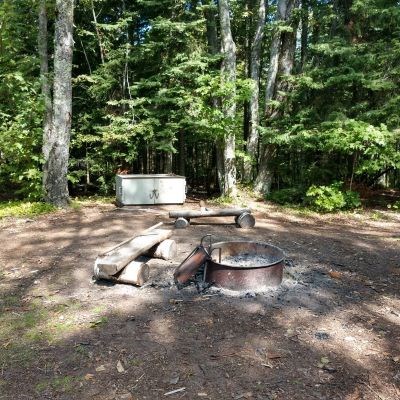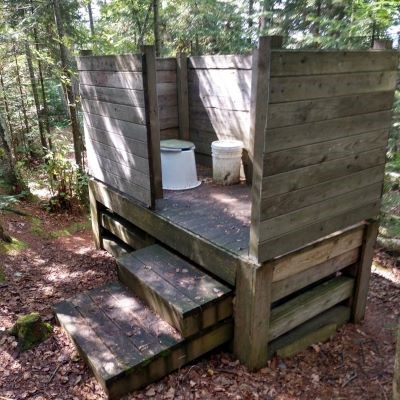
Cat Island Site 1Location: Southwest corner of the island, approximately 100 yards north of the sandspit Amenities: fire ring, food locker, mouldering privy. 
[NPS Photo] Wilderness Management PlanIn anticipation of a new Wilderness Management Plan for the Apostle Islands National Lakeshore, some changes are being made to the campsite on Cat Island in order to better protect the fragile resources on this beautiful sandspit. Prior to this year, the campsite and privy were located on the edge of this unique sandscape resulting in very visible impacts. Fragile beach grasses and shrubs were trampled and destroyed, and social trails created throughout the sandspit and beach area. To mitigate these impacts, in spring of 2009 the campsite and privy were relocated, a floating boardwalk was placed in the new campsite area, and heavily disturbed areas were revegetated with nearly 5,000 native plants. The result will be a unique camping experience not found elsewhere in the Apostle Islands. The goal of future campsite relocations will be modeled on this example.Preserving Wilderness CharacterCat Island is a part of the Gaylord Nelson Wilderness area, which comprises 80 % of the land area inside the park. The designation guarantees the highest level federal protection for lands owned by the United States. The Wilderness Act of 1964 defines wilderness as “…an area of undeveloped Federal land…without permananent improvements or human habitation, which is protected and managed so as to preserve its natural conditions and which generally appears to have been affected primarily by the forces of nature; and has outstanding opportunities for solitude or a primitive and unconfined type of recreation…” After being althered by centuries of human use, the Cat Island ecosystem is “rewilding” and once again has these wilderness characteristics.New Campsite DesignCat Island is a part of the Gaylord Nelson Wilderness area, which comprises 80 % of the land area inside the park. The designation guarantees the highest level federal protection for lands owned by the United States. The Wilderness Act of 1964 defines wilderness as “…an area of undeveloped Federal land…without permananent improvements or human habitation, which is protected and managed so as to preserve its natural conditions and which generally appears to have been affected primarily by the forces of nature; and has outstanding opportunities for solitude or a primitive and unconfined type of recreation…” After being althered by centuries of human use, the Cat Island ecosystem is “rewilding” and once again has these wilderness characteristics.A New Approach to Backcountry Waste ManagementThe moldering privy concept was developed in a continuing research project by the Green Mountain Club in conjunction with the Appalachian Trail Conference, the National Park Service Appalachian Trail Park Office, and the Vermont Department of Forests, Parks and Recreation. The goal was to develop a waste management system to replace the traditional pit toilet and designated toilet (cat hole) area with a system that manages human waste with less maintenance than other composting systems. The moldering privy is experimental, but it has great promise for disposal of human waste in the backcountry… it requires less labor and exposes maintainers to less risk of infection than bin composting systems, and is much less polluting than pit toilets. It also eliminates the need to dig new pits and it can serve a higher volume than pit toilets…” (Green Mountain Trail Club) At Cat Island, it replaces the vault toilet, which requires periodic labor and energy-intensive pumping.The Moldering PrivyThe moldering privy represents a commitment on the part of the Park to reduce its environmental and social impact by choosing green strategies for management. The privy structure and process aligns with the Wilderness character of the site by providing a solution with less of an impact on the natural and cultural resources in addition to enhancing the visitor experience. The privy will benefit the park by reducing costs and our environment impact. The other 35 toilets in the park are of the vault style, which require the use of a Korean War era Landing Craft hauling a pumper truck to remove their contents. The moldering privy, once in place, will never again require this type of trip, thus reducing the overall impact to the site and preserving its wilderness characteristics.How It WorksMoldering is a process by which organic material is broken down to become compost. Due to its crib design allowing for maximum air flow, human waste is broken down by the constant aeration of the pile, the introduction of biological organisms that break down organic matter, and time. Think of it as a cool composting system. Waste is also treated by organisms in the layer of topsoil located below and surrounding the structure, similar to what a conventional mound system does. Users will throw a handful of forest duff from a container on to the pile after each use. Duff is added because doing so incorporates the organisms that break down the leaves into the pile and eventually the pile as well. When the bin gets full, the hole is covered and allowed to compost over a period of one year, which is approximately the same amount of time it takes for toilet paper to fully degrade. At the end of that year, the contents will be removed and tested for bacteria before being returned to the forest floor.The LocationThe new campsite is located on the east side of the sandspit at the site of a cabin that was removed in 2008. The old cabinsite has been transformed into the new style of campsite, while the site of the old campsite has been restored. Please use the wooden boardwalk on the western side of the sandspit to access the site and privy. Help us “rewild” this fragile area by staying on the the established trails. |
Last updated: June 23, 2022
